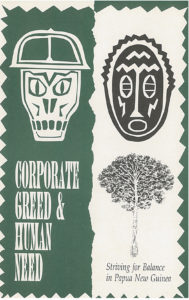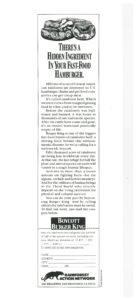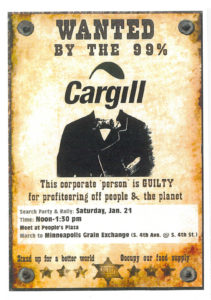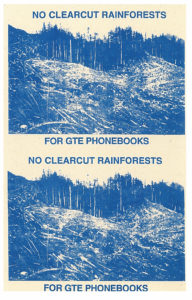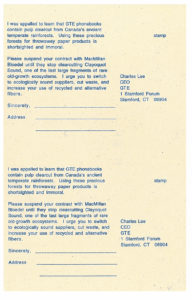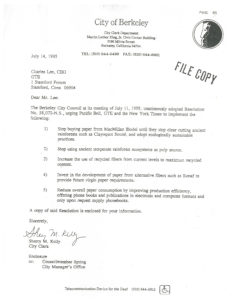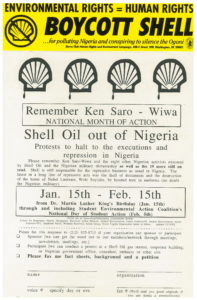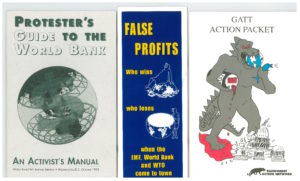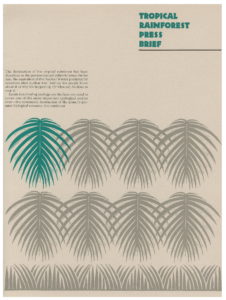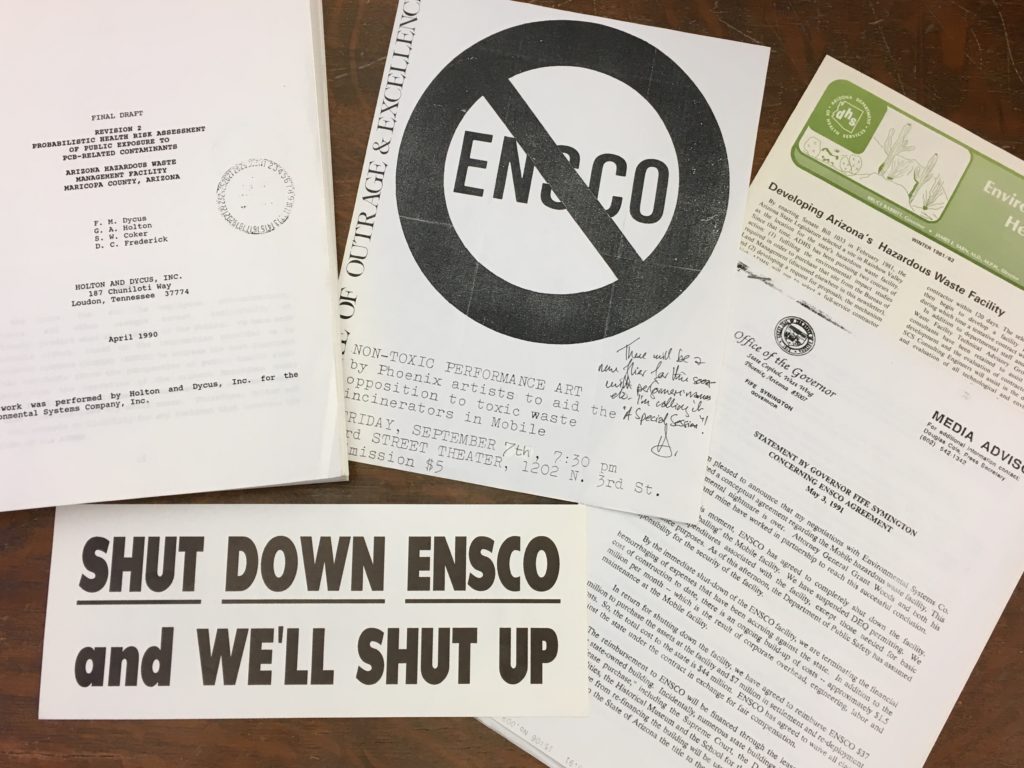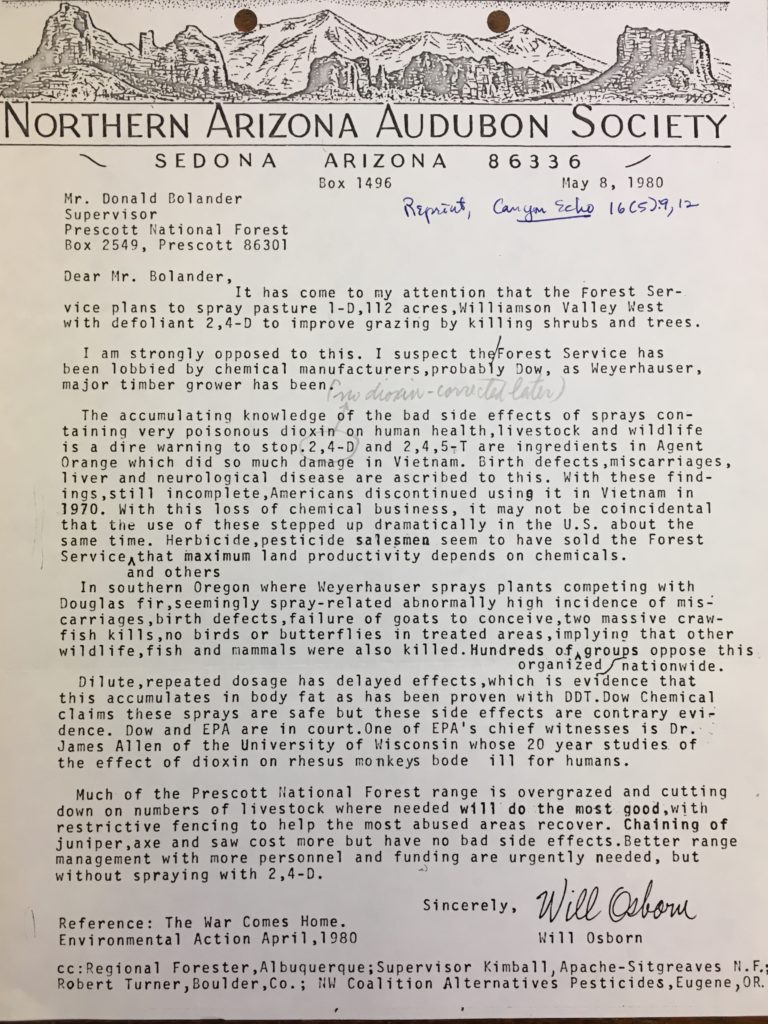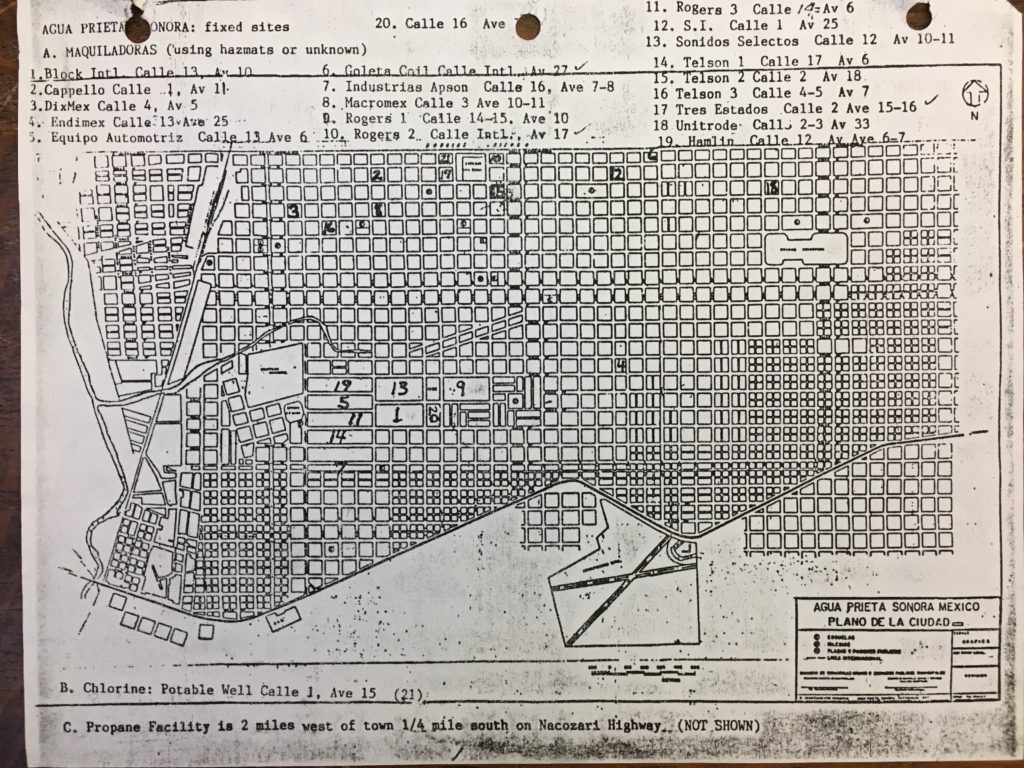Tag: American history
Additions to the Rainforest Action Network Records Now Open at The Bancroft Library
At first I thought I was fighting to save the rubber trees;
then I thought I was fighting to save the Amazon rainforest.
Now I realize I am fighting for humanity.
– Chico Mendes (1944-1988)
The Bancroft Library is pleased to announce that a series of additions to the ongoing Rainforest Action Network records is now open and accessible to researchers. The processing of the Rainforest Action Network records is part of a two-year grant project funded by the National Historical Publications and Records Commission to make available a range of archival collections relating to environmental movements in the West. A leading resource in the documentation of U.S. environmental movements, The Bancroft Library is home to the records of many significant environmental organizations and the papers of a range of environmental activists.
Rainforest Action Network was founded in 1985 by Randy “Hurricane” Hayes and Mike Roselle as a San Francisco based non-profit grassroots environmental group with a mission to protect and preserve the world’s forests and defend the human rights of indigenous people and others affected by unjust land grabs and the depletion of natural resources. Rainforest Action Network’s direct action, education and marketing campaigns apply pressure to governments and corporations to halt illegal logging, manufacturing, selling and use of old growth trees and tropical forests.
The global breadth of Rainforest Action Network’s activities range from Old Growth campaigns in Northern California, the Pacific Northwest and Canada to Tropical Timber campaigns to protect forests and indigenous rights in Central and South America, Africa, Tasmania and Southeast Asia. They also include the Global Finance campaign which organized and supported civil disobedience during the World Trade Organization meetings in Seattle, Washington in 1999.
The Bancroft Library has been collecting Rainforest Action Network records since 2006 and the newly opened additions document the group’s campaigns primarily in the 1990s-2000s. Future additions to the records are expected.
OHC Director’s Column, May 2019
Every April, as the school year is fast coming to a close, the Oral History Center hosts its very own commencement ceremony. For seven years running, we have produced this event to celebrate the oral history class of that year — meaning we thank and honor those people whose interviews were completed in the previous year. The Oral History Class of 2019 numbered some 111 individuals who participated in a number of oral history projects ranging from environmental regulation and wine growing to philanthropy and scientific discovery to opera and an army base.
This very special event gives us an opportunity to reflect on what we do — the meaning of oral history to us, to our narrators, and to the community at large. This year we were thinking about how oral histories “make history” in several ways: The interviews, once recorded and made available to the public, provide the raw material that is then used for the making of historical narratives by historians, journalists, students, you name it; the interviews offer historical narratives and analysis on their own, and thus they are one account of history, maybe the best first draft of history; and, perhaps most importantly, those we interview have already made history by living their lives — by building corporations, participating in social movements, creating works of art, running for political office, serving in the military, mentoring students . . . by making wine! History happens — and has happened — but through the work of the Oral History Center, and the generous and essential contributions of our narrators, history is made.
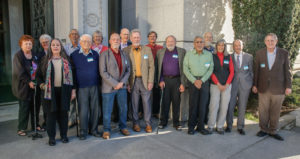
In advance of the event, I asked my colleagues for some examples of moments from their interviews when history was made — when something was told that seemed new to the historical record or in some way demanded a rethinking of it; when a narrator provided an account of a previously unrecognized contribution made — really any example of when history was made.
Amanda Tewes, in her first interview for the center, interviewed Jeanne Rose, who joined us the for event, which was held on this year on Thursday, April 25. Jeanne is a remarkable woman who, in her interview, provided deep insight into something that most people think they know well: the 1960s counterculture. In her telling, we learn of a loose-knit group who were the first 100 to populate the Haight-Ashbury, their deep connections to Big Sur, and how they began to change history with the “Summer of Love” in 1967. We further learn that 60s counterculture didn’t die at the infamous and bloody Altamont concert (which she attended) as the majority of her interview covers the 1970s and beyond when she became an influential herbalist and aromatherapist. With Jeanne Rose, the ideals and the spirit of the 60s live on. Jeanne Rose made history.
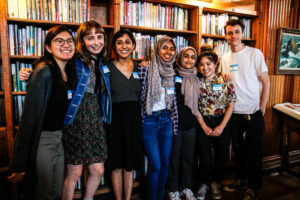
Maggie Deng, Carla Palassian, Gurshaant Bassi, Tasnima Naoshin, Aamna Haq, Laurel Fujii, Ben Satzman. Not pictured: Yarelly Bonilla-Leon, Cindy Jin, KD Mireles, Mason Osberg.(Photo by J.Pierre Carrillo for the UC Berkeley Library)
Todd Holmes, a historian with the Center since 2016, has created a remarkable project documenting the origins of the academic field of Chicano/a Studies, and for this he interviewed Ed Escobar, an Arizona State professor. In his oral history, Escobar tells how he pioneered some of the earliest Latino history courses — out of necessity because there were none. Teaching on the East Coast and then the midwest he learned that the Mexican American experience did not resonate like it did in California. But the Cuban, Puerto Rican, Dominican did. So he put together one of the first Latino history classes on those regions, expanding the definition of Latino and Latino studies in the process. Ed Escobar made history.

We have been fortunate to partner with the East Bay Regional Park District for a few years now and we’ve done a few dozen interviews already — covering many different topics from ranching to public education. Shanna Farrell, who is the project director and lead interviewer, shared with me a moment in her interview with Lawson Sakai. Sakai’s parents were from Japan, so in World War II, his family left the mandated West Coast exclusion area to avoid internment, ultimately settling in Colorado. They returned to California and to farming after the war, but with no money and an unwelcoming attitude of locals, this wasn’t easy. Enter Driscoll Farms, which is a larger grower of fruits today. Immediately after the war, they offered the returning Japanese-Americans a good deal, which included a 50/50 split on profits from the strawberry harvest. According to Sakai, this helped many families back on their feet after the war, allowing them to earn enough money to buy their own farms and thus independence. Shanna said, “I scoured my food history books and didn’t find any information about this. I felt like I had stumbled upon a hidden historical gem.” Lawson Sakai made history.
This past year we renewed our long-running partnership with the Sierra Club to document the organization’s history, and Roger Eardley-Pryor conducted two interviews this year, one with former president Michele Perrault. Roger recalled for me how this interview provides a unique and personal window into the international dimensions of environmentalism. Perrault told stories of traveling to the Soviet Union, China, and India in the early 1990s where she and her colleagues networked with proto-environmental groups, teaching them how to organize and what the key issues were. Their work resulted in, among other things, the creation of some of the first nature preserves in those countries and the establishment of the robust network that is in place today. Michele Perrault made history.
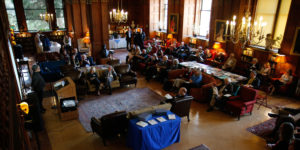
In the coming weeks and months, we will release the oral histories that are not already posted online. This past year we conducted at least 500 hours of new interviews and we are deeply grateful for the support of numerous individuals and institutions for making this work possible. Soon we will begin to post the names of these sponsors on our website so you can thank them too. In the meantime, enjoy the photos and our video from the commencement, highlighting interviews from the Oral History Center Class of 2019.
Our 10-minute video features highlights from the interviews of all of the narrators who were able to attend commencement, plus some bonus interviews. Our remarkable narrators share their insights about nature, science, art, the university, wine making, and more.
Martin Meeker, Charles B. Faulhaber Director, Oral History Center, UC Berkeley
Over the decades, the Oral History Center has conducted more than 4,000 interviews on almost every topic imaginable. As part of UC Berkeley’s commitment to open access, the transcripts are available to researchers and the public at no cost, and almost all of the transcripts are available online. Search our vast collection.
Primary Sources: New Deal and World War II: President Franklin D. Roosevelt’s Office Files and Records of Federal Agencies (1933-1945)
New Deal and World War II: President Franklin D. Roosevelt’s Office Files and Records of Federal Agencies (1933-1945) includes materials deemed especially important by the President on the basis of content and source. Major topics covered in the files are the Great Depression, the New Deal, America’s involvement in World War II, the internal workings of the Roosevelt administration, and Roosevelt’s personal leadership style. Several additional collections include the FBI Reports of the Franklin D. Roosevelt White House; Civilian Conservation Corps Press Releases; Department of Treasury records; and a special set of documentary records on the Roosevelt Presidency covering 50 important episodes and themes of the Roosevelt presidency. Of particular interest are the Records of the Committee on Economic Security, an advisory board tasked by the President to propose measures that would ensure economic security for Americans. It’s final report was the blueprint for what would become the Social Security Act.
Environmental Justice Grit in the Borderlands
Environmentalists make terrible neighbors, but great ancestors. – David Brower
It would be difficult not to notice a common thread of diligent, dogged persistence across the broad spectrum of environmental justice activism. This tenacity, coupled with a long view of the world and a whole lot of hard work, is what makes for some of the most successful environmental justice campaigns.
While success cannot be measured in one brief moment or win where environmental issues are concerned, each victory adds to the larger picture of global environmental awareness and health of the planet. Multiple stories of such environmental justice grit can be found in the collections at The Bancroft Library and one collection in particular is the newly opened records of Arizona Toxics Information.
Focused primarily on environmental concerns in the Arizona/Mexico border region during the 1970s through 1990s, Arizona Toxics Information was founded by conservationist Michael Gregory in 1990. The collection also includes materials collected by Gregory before Arizona Toxics Information was established when he worked with the Sierra Club Grand Canyon Chapter and grassroots environmental groups. Gregory had been employed by the United States Forest Service in the early 1970s and had witnessed the spraying of herbicide 2,4,5-T in national forests while he was stationed at fire outlook towers. 2,4,5-T is one of the main components of Agent Orange, which had already been banned for use in Vietnam due to its known harmful health effects and birth defects. From there, Gregory set about to research, collect information, write articles and lobby to end the practice of herbicide, pesticide and insecticide spraying in national forests and range lands.
In addition to the fight for pesticide use awareness and regulations, Arizona Toxics also ran several successful campaigns to shut down the Phelps-Dodge Corporation’s Douglas Reduction Works (copper smelter), the ENSCO hazardous waste management facility (PCB incinerator), and to improve the overall air and water quality of Arizona. As the Environmental Protection Agency’s Integrated Environmental Plan for the U.S.-Mexico Border Area and the North American Free Trade Agreement (NAFTA) were being drafted in the early 1990s, Arizona Toxics Information lobbied and organized grassroots groups on both sides of the border to share information and rally for a multitude of environmental commitments in the agreements. These commitments included providing the public the “right-to-know” about pollutants being released from factories on both sides of the United States-Mexico border, regulating maquiladoras (factories in Mexico that are generally owned and operated by foreign companies which assemble products often to be exported back to the country of that company), and developing emergency disaster plans to respond to hazardous waste accidents.
The current status of NAFTA casts some doubt on the future of these agreements. The opening of the records of Arizona Toxics Information provides timely documentation of hard-won environmental justice victories on the US-Mexico border.
The processing of the Arizona Toxics Information records is part of a two-year NHPRC-funded project to process a range of archival collections relating to environmental movements in the West. A leading repository in documenting U.S. environmental movements, The Bancroft Library is home to the records of many significant environmental organizations and the papers of a range of environmental activists.
Primary Sources: Presidential Recordings Digital Edition
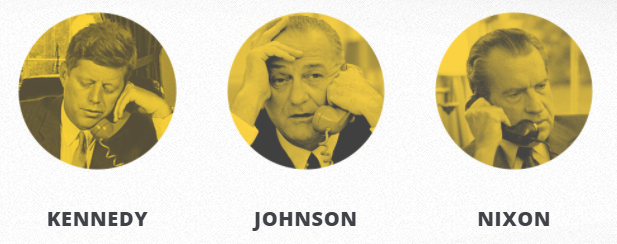
The Library has acquired Presidential Recordings Digital Edition, an online portal for annotated transcripts of telephone conversations of Presidents Johnson, Kennedy, and Nixon. Recordings and transcripts are presented together. The transcripts are searchable and browseable by administration, series, speaker, date, place, and duration.
Trial: North American Immigrant Letters, Diaries, and Oral Histories
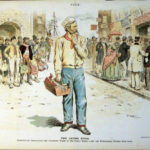 Until 2/15/2018 the Library has a trial set up for North American Immigrant Letters, Diaries, and Oral Histories
Until 2/15/2018 the Library has a trial set up for North American Immigrant Letters, Diaries, and Oral Histories
This text-based collection includes over 100,000 pages of material, including Ellis Island oral histories, scrapbooks, pamphlets, previously unpublished diaries, and more, related to the immigrant experience in America.
In Memory of Ruth Bancroft 9/2/1908 – 11/26/2017

UC Berkeley alumna Ruth Petersson Bancroft, founder of The Ruth Bancroft Garden in Walnut Creek and well-known expert in dry gardening, passed away at the age of 109 on Nov. 26. Her oral history, The Ruth Bancroft Garden in Walnut Creek, California: Creation in 1971 and Conservation, conducted in 1991 and 1992, is described by interviewer Suzanne B. Riess as “…the amazing chronicle of the growth of a passionate gardener, from her childhood recollections of spring wildflowers on the hills of an earlier, bucolic Berkeley, to her current triumphs, and the tribulations of stewardship of a garden more or less in the public trust.”
The daughter of first-generation Swedish immigrants, Ruth Petersson was born in Massachusetts, but moved to Berkeley, California when her father landed a professorship at UC Berkeley. Of her childhood, she said, “I spent a lot of time wandering around and also over into Wildcat Canyon, just looking at the wildflowers and I think that’s what started me in the interest of wildflowers…” Although Ruth originally studied architecture as one of the only women in the program at UC Berkeley, the Great Depression hit and so for the sake of job security, she switched her career to education. It was during her time as a teacher of home economics in Merced that she met Philip Bancroft, Jr., the grandson of Hubert Howe Bancroft, whose 60,000-volume book collection began the Bancroft Library. After they married, the couple moved onto the Bancroft Farm in the East Bay. The Bancroft family sold much of their land to the city of Walnut Creek as it expanded over the years. Later, in 1971, Philip Bancroft, Jr. gave the last 3-acre plot of walnut orchards to his wife in order to house her extensive collection of succulents.
Though The Ruth Bancroft Garden now boasts a beautiful display of water-conserving plants, the garden was not without its hardships at the beginning. Just a few months after Bancroft began her garden, a severe freeze in December killed nearly all that she had planted. Still, she persevered. “Well, I started again the next year… I figured it doesn’t happen that often, and you can’t just not replant those same things, because they might have another twenty years before they’d be killed again. So I’m just replanting. Have to start over again.” To this, Riess queried, “You didn’t think in some way you had been given a message?” Bancroft laughed and replied, “No.”
A long-time friend of Bancroft and former manager at the UC Berkeley Botanical Garden, Wayne Roderick said, “I would classify Ruth as a genuine dirt gardener. She’s out there doing things with her bare hands. She would be out in the garden by seven at the latest, and for the first hour she was weeding the path of the little spotted spurge, hand-weeding those paths until her knees would get so sore from the rocks, the gravel. That’s what I mean by a genuine dirt gardener.” In addition to Bancroft’s hands-on style of working, she also kept meticulous records as she created her garden. An invaluable addition to her oral history is the transcription of the entirety of her handwritten notes on the garden’s first year, cataloguing every trial and triumph. Riess urges in her introduction to the oral history, “Any gardener will do well to read that year of Ruth’s journal, to see the value of a journal, as well as the work involved in realizing a dream, and the necessity of being willing to weed!”
Over the years, Bancroft also had many helpers that contributed to the development of her impressive creation, such as Lester Hawkins, who created the original design of the garden, and her husband Philip. Roderick recalls, “Phil Bancroft just adored Ruth, and he wanted her to have anything she wanted. He did everything he could to help her. I don’t think Phil thought about the garden continuing, but he certainly was there to make sure she got what she wanted for the place. He was a farmer-type, but he enjoyed seeing the garden, and he was willing to get in and help.” Later, her garden would inspire fellow gardener Francis Cabot to create the Garden Conservancy, of which the Ruth Bancroft Garden became the first of many private gardens to be preserved for the public.
Still, through all of the international recognition and acclaim she received, Bancroft maintained a simple and genuine love for gardening: “You never know just what’s going to bloom when, during the summer. And a lot of the bloom just lasts a day, or possibly two days. It’s interesting to see what there is, and catch it before it’s gone.” When asked whether she had had a mission for the garden, she replied, “I just started it for the fun of it, and the enjoyment of it. I had no idea that people would be looking at it, no idea at all.“
Maggie Deng
Oral History Center Student Assistant
Announcing the Release of the California / San Francisco Fire Departments Oral History Project
The world of firefighting is much more than masked people in uniforms running into burning buildings and rescuing scared cats from trees. While the bravery of firefighters can’t be overestimated, they also work in a complex system that requires constant training and education, a cohesive partnership with local government, extensive procedures and protocols, managerial oversight, effective communication within departments and to the public, acute familiarity with the local and regional environment, and a whole lot of administrative work. The San Francisco Fire Department (SFFD) is a shining example of how people make a civil service operation run and keep people safe. All of these elements, as well as the historic and cultural aspects of the department, are why we chose it as our focus for our California Fire Departments Oral History Project.
The project was originally conceived by Sarah Wheelock, an independent researcher. She wanted to explore several major thematic areas of firefighting in California and she worked with the Oral History Center to do just that. With great sadness we learned that Sarah passed away in 2014 and thus she was unable to see the project through to completion. Taking over the project in 2016, I wanted to honor her original plan and cover the themes that she had outlined. So, I decided to embark on interviews within one department – the SFFD – to document the ways in which they have handled urban fire, climate change, diversity, technological change, and changing demographics.
The SFFD was founded in 1849 and was run by volunteers. It became a paid department, officially integrated into city government, in 1866. The 150th anniversary of the paid department was in 2016, when I was conducting interviews. Given my budget for the project, I was able to interview six people who worked with the SFFD in different capacities. I wanted to include multiple perspectives to understand the organizational, cultural, geographic, economic, and political systems of one of the oldest departments in the country.
The individuals who I interviewed were able to illustrate many of the themes that I wanted to document, and much more. Among the six people I interviewed were Chief Robert Demmons (the first and only African American chief of the SFFD who instrumental in integrating more more women and people of color into the SFFD), Bill Koenig (longtime firefighter and co-founder of Guardians of the City and the SFFD Museum), Jim Lee (also a longtime firefighter and co-founder of Guardians of the City and the SFFD Museum), Steve Nakajo (member of the SFFD Fire Commission), Lt. Anne Young (one of the first females hired), and Jonathan Baxter (longtime paramedic and current Public Information Officer).
These interviews work in concert to illustrate day-to-day operations in the stations, administrative duties, how the city of San Francisco and the department work together, the relationship between paramedics and the department, training, equipment, fire science school, the role of unions, the challenges and triumphs of integrating the departments, the public perception of the department, the role of innovation and changing technology, cultural changes in the department, challenges in fire safety particular to the geography of San Francisco, and the hopes for the future of the SFFD.
It is with great excitement that we present the California / San Francisco Fire Departments Oral History Project. I want to give a special thanks to all of the narrators for sharing their stories with me and helping me to document one of the most historically significant fire departments in our country.
This project is dedicated to the memory of Sarah Wheelock. Her California Firefighter oral histories from the 2000s will be released in early 2018.
Primary Sources: Life Magazine Archive
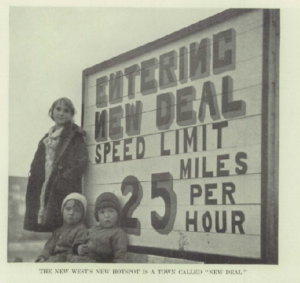 As described on its website, Life Magazine Archive “presents an extensive collection of the famed photojournalism magazine, spanning its very first issue in November, 1936 through December, 2000 in a comprehensive cover-to-cover format.
As described on its website, Life Magazine Archive “presents an extensive collection of the famed photojournalism magazine, spanning its very first issue in November, 1936 through December, 2000 in a comprehensive cover-to-cover format.
“Published by Time Inc., the magazine has featured story-telling through documentary photographs and informative captions.Each issue visually and powerfully depicted national and international events and topical stories, providing intimate views of real people and their real life situations.
“Articles and cover pages are fully indexed and advertisements are individually identified, ensuring researchers and readers can quickly and accurately locate the information they seek. Life Magazine Archive is valuable to researchers of 20th-Century current events, politics and culture, as well as those interested in the history of business, advertising, and popular culture.”
The covers, articles, and advertisements can all be searched. It is also possible to browse through an issue, once a page of the issue has been retrieved.
Trial: Newspapers and Associated Press collections
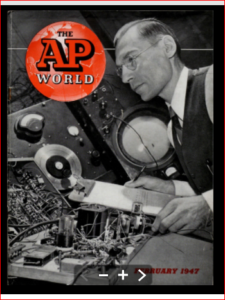 Until October 20, 2017, the Library has trial access to the following resources:
Until October 20, 2017, the Library has trial access to the following resources:
Associated Press Collections including,
Associated Press: European Bureaus Collection
Associated Press: Middle Eastern Bureaus Collection
Associated Press: News Features & Internal Communications
Associated Press: US City Bureaus Collection
Associated Press: Washington Bureau II Collection
Associated Press: Washington/D.C. Bureau Collection
Daily Mail Historical Archive
International Herald Tribune
The Telegraph Historical Archive, 1855-2000
Your feedback on the usefulness of these is greatly appreciated.
